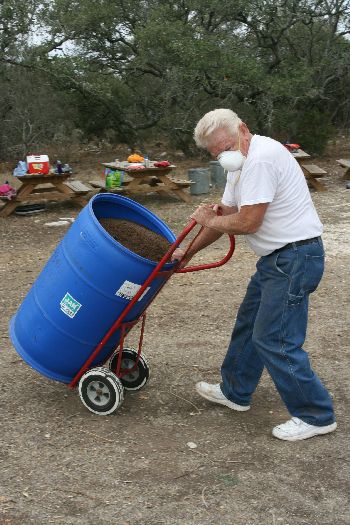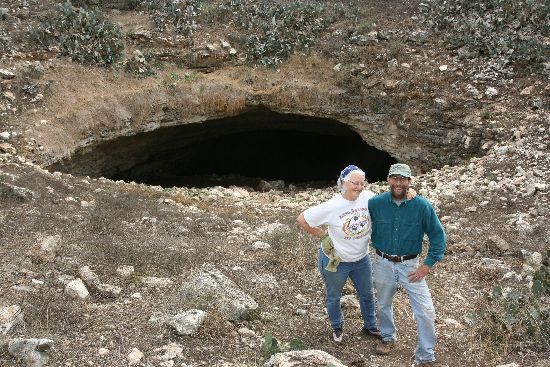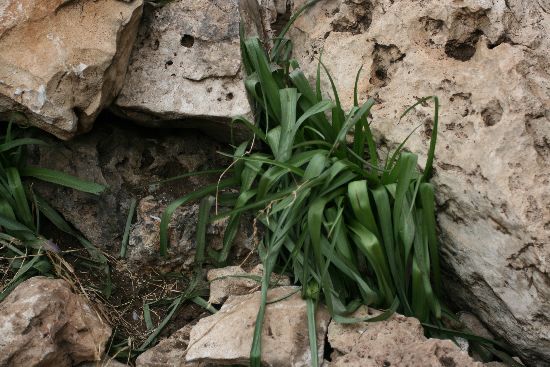Sunday, February 08
It is an old story. For over 10,000 years, the bats have come to Bracken Cave every Spring. Probably beginning as soon as the last Ice Age receded northward, allowing the sun to warm up the coastal bend of a place we now call Texas. The bats bred. Raised their young. Hung themselves in tightly packed clusters from the cave ceiling. And at twilight, they flowed on whirring wings into the night sky. Millions of them. Until a trickle turned into a winding, twisting river of Mexican free-tailed bats, ready to feast on the protein-rich, airborne insects migrating over the limestone hills."
Source: Bat Conservation International
Bracken Cave is the home to 20 to 40 million Mexican free-tailed bats. When you get that many bats- and their babies, you get a lot of guano.
Bat guano has been used in agriculture in many regions of the world for hundreds of years. In the 1600s in Peru, the Incas valued guano so highly that the punishment for harming the animals that produced it was death. During the late 19th century, it had become important enough to American farmers that the government offered free land to those who discovered guano deposits, provided the harvest was made available to U.S. citizens.
Bracken Cave is owned and managed by Bat Conservation International (BCI). BCI allows the commercial collection of bat guano by Garden-Ville, one of Central Texas' finest organic gardening emporiums. The product is used for an organic fertilizer for both ornamental and food crops.
Additionally, once a year there is the Guano Gathering when cavers from the San Antonio / Austin area converge on the cave with 100s of buckets, barrels and trash cans. Once the bucket brigade is organized and in place, the guano harvest begins. When it is over, folks go home with some mighty fine organic fertilizer.
I was fortunate enough to be in the San Antonio area for the 10th Annual Guano Gathering at Bracken Cave. Below are photos I took before and after I joined the bucket brigade.
Click on the photos below for a higher resolution image.
They will be slow to load with a dial-up connection.

Signage just inside the gate the gate at Bracken Cave preserve.
» 20-40 million bats, the largest concentration of mammals in one place in the world
» Each night they eat an estimated 200 tons of insects
» During the day, they are packed onto the cave walls at over 200 individuals per square foot
» Body heat from the bats raises the temperature in the cave from a natural 68 degrees to an incubational 108 degrees

Informational sign near the entrance slope of Bracken Cave.

This was my first glimpse of the guano operation. Everyone was busy, busy, busy!

There were already quite a few barrels full of guano.

A close look at the "finished" guano. It is dry, fairly light weight and quite pungent.

Here is the end of the line which snaked down the slope and vanished into the cave.

The passing back and forth of the buckets was non-stop.

Once the buckets reached the end of the line they were dumped into larger containers for transport off site.
As the saying goes: "Many hands make light work". With dozens of people working together everyone is able to share in the fecal bounty while saving both time and effort.

At the end of the line large containers brought by the Guano Gatherers were busily being filled. The lucky recipients of this brown gold will see the results in their bounty when the guano is spread and worked into the soil of their vegetable and flower gardens.

As each bucket was dumped, the next one came in short order.

One of many filled barrels which had to be moved from the end of the bucket brigade line to the loading area.

Here, the emptied buckets are being passed back down the line to the cave to be refilled from the deep piles of guano which lie within.

This is the scene I saw after I scrambled down the slope to the cave entrance.

Here, the buckets are being handed off from the hard working folks who had just filled them. Regretfully I have no photos of the them as the dug the guano and laboriously filled each bucket.

Even the little ones pitched in where they could.

Ones filled, the buckets are passed hand to hand until they reached the filling station. Seeing and being part of this gives one a sense of the labor involved to remove the guano prior to the time when it's removal was mechanized.

Geary takes a coupla buckets and sends them on up the slope.

The kids were having a good time helping out.

A tired, but satisfied bunch of Guano Gatherers pose for a group photo.

Now, the job of putting all the fully loaded containers into the various vehicles begins.
LIFT!

PUSH!

and ROLL!

All quiet on the cave front... until next year's gathering.

Two happy Gatherers.

A mystery plant near the cave entrance. I was struck by it's lush and turgid appearance considering the drought conditions. Can you ID this plant for me?

This shot is looking towards the entrance from a few hundred feet back in the cave. Note all the particles in the air.

The folks were looking at bat mummies and skeletons.

Geary stands out in silhouette only as I take my last shot of this impressive and beautiful cave entrance.

The obligatory "rusting old car shot".
Thanks to everyone, especially Geary, for making this a truly unique and fun day.
Week 3: Day 16 - FINIS


